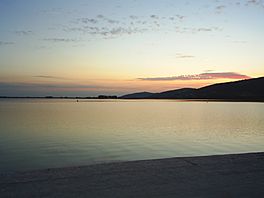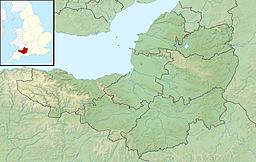Cheddar Reservoir facts for kids
Quick facts for kids Cheddar Reservoir |
|
|---|---|

at dusk looking towards the western edge of the Mendip Hills and Crook Peak
|
|
| Location | Somerset |
| Coordinates | 51°16′50″N 2°48′5″W / 51.28056°N 2.80139°W |
| Type | reservoir |
| Primary inflows | inlet from Cheddar Yeo |
| Basin countries | United Kingdom |
| Surface area | 105.4 ha (260 acres) |
| Site of Special Scientific Interest | |
 |
|
| Area of Search | Somerset |
|---|---|
| Coordinates | 51°16′50″N 2°48′05″W / 51.2806°N 2.8014°W |
| Interest | Biological |
| Area | 105.4 hectares (1.054 km2; 0.407 sq mi) |
| Notification | 1972 |
Cheddar Reservoir is a big, man-made lake in Somerset, England. It's managed by a company called Bristol Water. This reservoir was built in the 1930s and can hold a huge amount of water – about 6.14 million cubic metres!
The water for the reservoir comes from the Cheddar Yeo river, which flows through Cheddar Gorge. You can even see the large pipe that brings the water into the reservoir. The reservoir is located near the village of Cheddar and the town of Axbridge. Sometimes, people call it the Axbridge Reservoir because of this. It's shaped like a circle and has large earth banks around it where sheep often graze.
Contents
Building Cheddar Reservoir
The reservoir was built by a company called Sir Robert McAlpine. It was finished in 1937. This reservoir was special because it was the very first one in Britain where people were allowed to go sailing!
What You Can Do at the Reservoir
Cheddar Reservoir is a special place for nature, especially for birds in winter. It has been named a Site of Special Scientific Interest (SSSI) because of the many different water birds that visit.
There are two car parks where you can access the reservoir. One is near Axbridge, and the other is on the eastern side, closer to Cheddar. You'll also see two water towers, one at each end of the reservoir.
Many fun activities happen here!
- The Bristol Corinthians sailing club is located at the northern end.
- You can go windsurfing on the water.
- People also enjoy angling (fishing) for fish like pike, tench, roach, perch, and eels.
- It's a fantastic spot for birdwatching too!
Amazing Bird Life
The reservoir is a great place for waterbirds, especially during winter. Many different kinds of wildfowl (like ducks and geese) and gulls come here.
Winter Visitors
In winter, you can regularly spot many types of wildfowl, including:
- Mallard (Anas platyrhynchos)
- Gadwall (Anas strepera)
- Tufted duck (Aythya fuligula)
- Common pochard (Aythya ferina)
- Eurasian wigeon (Anas penelope)
- Common goldeneye (Bucephala clangula)
- Goosander (Mergus merganser)
You'll also see a large group of coot (Fulica atra) and many great crested grebe (Podiceps cristatus).
Rare Birds
Because Cheddar Reservoir is close to the Bristol Channel, sometimes strong storms blow seabirds inland. You might occasionally see birds like shag, grey phalarope, and different kinds of divers and grebes.
The reservoir also attracts some rare gulls, such as glaucous, Iceland, and ring-billed gulls.
Over the years, many rare and unusual vagrant birds have been seen at Cheddar Reservoir. These are mostly waterbirds and shorebirds. Some of the rare species spotted include:
- American wigeon
- Green-winged teal
- Ring-necked duck
- Ferruginous duck
- Black-winged stilt
- Kentish plover
- American golden plover
- Temminck's stint
- White-rumped sandpiper
- Pectoral sandpiper
- Buff-breasted sandpiper
- Marsh sandpiper
- Wilson's phalarope
- Red-necked phalarope
- Franklin's gull
- Whiskered tern
- White-winged black tern
- Richard's pipit
- Tawny pipit
- Common rosefinch
- Ortolan bunting
Plans for Another Reservoir
For a long time, Bristol Water thought about building a second reservoir right next to the existing one at Cheddar.
In 2007, they announced that building a new reservoir was one of their ideas for future water supply. This new reservoir would have been about the same size as the current one.
Survey work for the new reservoir started in October 2012, just south of the existing one. However, in 2018, the plans for the second reservoir were officially cancelled.


